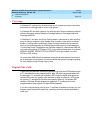
MERLIN LEGEND Communications System Release 6.1
Network Reference
555-661-150
Issue 1
August 1998
Feature Interactions
Page 3-4Barge-In
3
Extension Facility Restriction Levels (FRLs) are applied only to calls while they
are on the local system, and are compared both to UDP routes and to ARS
routes. For example, if a UDP route FRL is 1 and the caller’s extension FRL is 0,
the caller is unable to use the route, because the route FRL is higher than the
extension FRL. Similarly, if a caller is using ARS to call over another networked
system’s PSTN facilities, the extension FRL is compared only with the local ARS
route and its value must be equal to or greater than the route FRL value. Once a
call arrives at a non-local system, the extension FRL has no effect. The remote
system compares the FRL for its default COR for tie or non-tie trunks with that of
the FRL of the next chosen route, as described in “Remote Access Default
Class-of-Restriction Settings” on page 6.
Additional information about ARS is included in “Automatic Route Selection
(ARS)” on page 7. In addition, Chapter 2, “Call-Handling Scenarios,” includes
many routing examples.
Barge-In 3
Barge-In does not work for calls on a non-local system in a private network.
Callback 3
Callback queuing works for lines/trunks connected to the caller’s local system,
including private network tandem trunks. When a call is sent across the private
network and a non-local system’s extensions or trunks are busy, the caller cannot
queue the call using Callback.
When an extension with Automatic Callback activated originates a call to a non-
local extension and the local system’s trunks are busy, the call is queued at the
local system’s first route and the caller hears callback tone. If the caller is using
ARS or the non-local dial plan to call out over trunks connected to a remote
system and the outside facilities at the remote system are busy, the caller hears
the fast busy tone. The caller hears the busy tone if he or she is calling a busy
non-local dial plan extension. Neither call activates callback queueing because
the caller is not connected to the system from which the busy condition originates.
For Release 6.1 and later systems, when a call is routed to a calling group with a
non-local member and the local system’s trunks are busy, the call is automatically
queued for the first route even when the caller has not activated Automatic
Callback. Once a trunk becomes available, the system notifies the user and
completes the call. If the caller has Automatic Callback active and hangs up
before trunks are available, the call remains queued for an available trunk until a
trunk becomes available or the caller cancels the Callback request. If the caller
does not have Automatic Callback active and hangs up before trunks are
available, the call is disconnected.


















